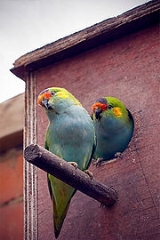
Purple-crowned Lorikeet
Encyclopedia
The Purple-crowned Lorikeet, Glossopsitta porphyrocephala, (also known as the Porphyry-crowned Lorikeet, Zit Parrot, Blue-crowned Lorikeet, Purple-capped Lorikeet Lory, Lorikeet, and Purple-capped Parakeet) is a lorikeet found in scrub and mallee
of southern Australia
. It is a small lorikeet distinguished by a purple crown, an orange forehead and ear-coverts, and a light blue chin and chest.
words porphuros "purple" and kephalē "head". Alternate common names include Porphyry-crowned lorikeet, Dietrichsen's Lory, and Zit Parrot, from its shrill call.
Its call is a high-pitched loud tsit, as well as chattering while eating in treetops.
Locally nomadic, it is often found in dry sclerophyll forest, especially where Eucalyptus
trees are flowering.
and Musk Lorikeet
s. It is a fast, straight flyer and dwells mainly in the forest canopy far above the ground.
species, and the boobialla (Myoporum insulare
) are among material consumed.
s, measuring 20 x 17 mm, is laid. The incubation period is around 17 days.
Mallee (biogeographic region)
Mallee, also known as Roe Botanical District, is a biogeographic region in southern Western Australia. Located between the Esperance Plains, Avon Wheatbelt and Coolgardie regions, it has a low, gently undulating topography, a semi-arid mediterranean climate, and extensive Eucalyptus mallee...
of southern Australia
Australia
Australia , officially the Commonwealth of Australia, is a country in the Southern Hemisphere comprising the mainland of the Australian continent, the island of Tasmania, and numerous smaller islands in the Indian and Pacific Oceans. It is the world's sixth-largest country by total area...
. It is a small lorikeet distinguished by a purple crown, an orange forehead and ear-coverts, and a light blue chin and chest.
Taxonomy
The Purple-crowned Lorikeet was first described by Lionel Dietrichsen in 1837, its specific epithet derived from the Ancient GreekAncient Greek
Ancient Greek is the stage of the Greek language in the periods spanning the times c. 9th–6th centuries BC, , c. 5th–4th centuries BC , and the c. 3rd century BC – 6th century AD of ancient Greece and the ancient world; being predated in the 2nd millennium BC by Mycenaean Greek...
words porphuros "purple" and kephalē "head". Alternate common names include Porphyry-crowned lorikeet, Dietrichsen's Lory, and Zit Parrot, from its shrill call.
Description
Measuring around 15 cm (6 in) long, the male Purple-crowned Lorikeet is a small lorikeet with a dark purple crown, a yellow-orange forehead and ear-coverts, deepening to orange lores, and green upperparts, tinted bronze on the mantle and nape. The chin, chest and belly are a conspicuous powder blue, while the thighs and under-tail coverts are yellowish-green. The green tail has some orange-red coloration at the bases of the lateral feathers. The large crimson patches under the wings are visible when the bird is in flight. The small beak is black, the iris brown and the feet grey. The female is similar but has a darker iris, paler ear coverts and lacks the crimson patches. Immature birds are duller and lack the purple crown.Its call is a high-pitched loud tsit, as well as chattering while eating in treetops.
Distribution and habitat
The Purple-crowned Lorikeet is found in southwest Western Australia, and in southern South Australia, east from the southern Eyre Peninsula, through the Gawler Range and southern Flinders Ranges and across Victoria to East Gippsland. It is also found on Kangaroo Island. It is not found in Tasmania.Locally nomadic, it is often found in dry sclerophyll forest, especially where Eucalyptus
Eucalyptus
Eucalyptus is a diverse genus of flowering trees in the myrtle family, Myrtaceae. Members of the genus dominate the tree flora of Australia...
trees are flowering.
Behaviour
Generally found in small groups, the species may congregate in larger flocks, and may be in the company of Little-Little Lorikeet
The Little Lorikeet is a species of parrot in the Psittacidae family. It is endemic to Australia. It is a small parrot, predominantly green in plumage with a red face...
and Musk Lorikeet
Musk Lorikeet
The Musk Lorikeet is a lorikeet, one of the three species of the Glossopsitta genus. It inhabits south-central/eastern Australia. The Musk Lorikeet was first described by ornithologist George Shaw in 1790 as Psittacus concinnus, from a collection in the vicinity of Port Jackson in what is now...
s. It is a fast, straight flyer and dwells mainly in the forest canopy far above the ground.
Feeding
Blossoms of various Eucalyptus and MelaleucaMelaleuca
Melaleuca is a genus of plants in the myrtle family Myrtaceae known for its natural soothing and cleansing properties. There are well over 200 recognised species, most of which are endemic to Australia...
species, and the boobialla (Myoporum insulare
Myoporum insulare
Myoporum insulare is a shrub or small tree which occurs on dunes and coastal cliffs in Australia. Common names include Common Boobialla, Boobialla, Native Juniper and, in Western Australia, Blueberry Tree....
) are among material consumed.
Breeding
Breeding season is from August to December with one brood laid. The nest is a small hollow in a tree, often with a knot-hole entrance. Sometimes the species nests in colonies. A clutch of 2-4 matte white roundish eggEgg (biology)
An egg is an organic vessel in which an embryo first begins to develop. In most birds, reptiles, insects, molluscs, fish, and monotremes, an egg is the zygote, resulting from fertilization of the ovum, which is expelled from the body and permitted to develop outside the body until the developing...
s, measuring 20 x 17 mm, is laid. The incubation period is around 17 days.

